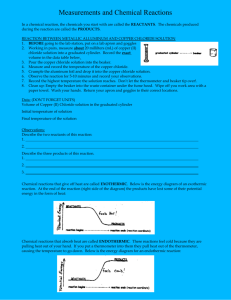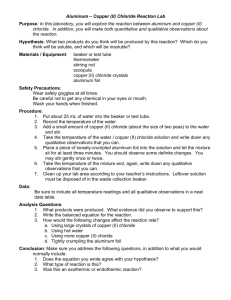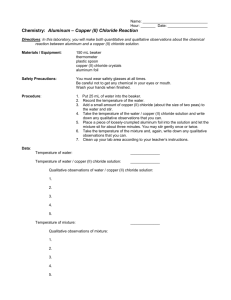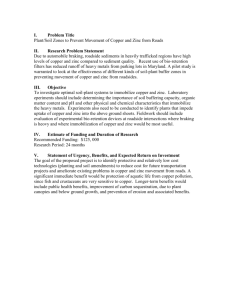Copper Chloride Empirical Formula Lab: Chemistry Experiment
advertisement
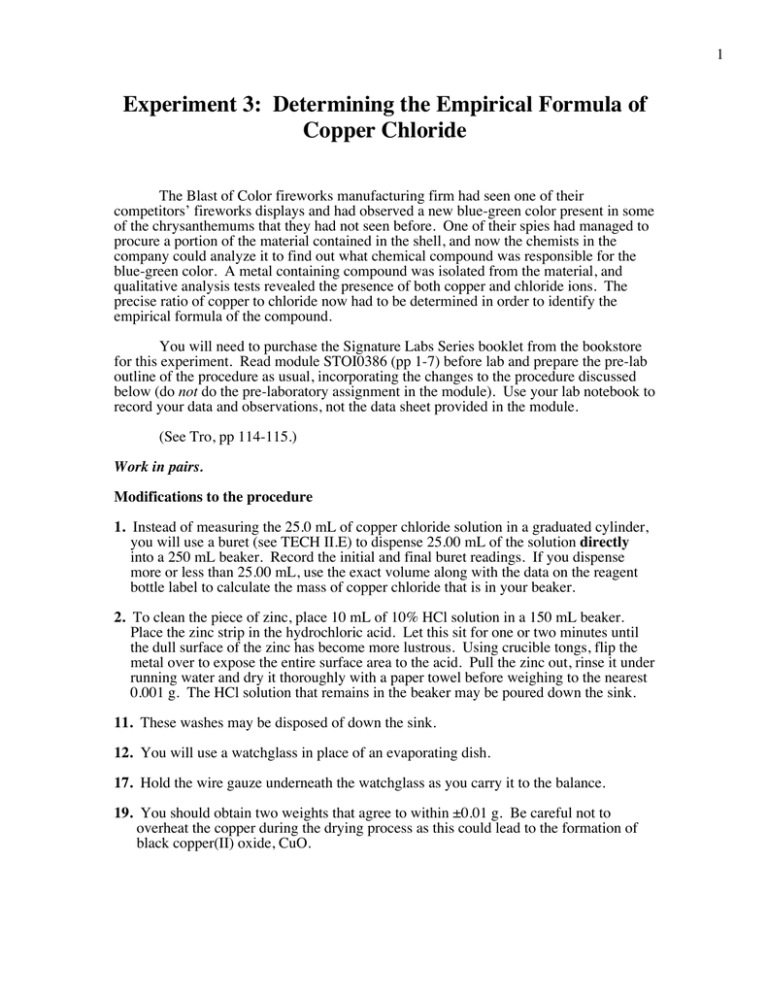
1 Experiment 3: Determining the Empirical Formula of Copper Chloride The Blast of Color fireworks manufacturing firm had seen one of their competitors’ fireworks displays and had observed a new blue-green color present in some of the chrysanthemums that they had not seen before. One of their spies had managed to procure a portion of the material contained in the shell, and now the chemists in the company could analyze it to find out what chemical compound was responsible for the blue-green color. A metal containing compound was isolated from the material, and qualitative analysis tests revealed the presence of both copper and chloride ions. The precise ratio of copper to chloride now had to be determined in order to identify the empirical formula of the compound. You will need to purchase the Signature Labs Series booklet from the bookstore for this experiment. Read module STOI0386 (pp 1-7) before lab and prepare the pre-lab outline of the procedure as usual, incorporating the changes to the procedure discussed below (do not do the pre-laboratory assignment in the module). Use your lab notebook to record your data and observations, not the data sheet provided in the module. (See Tro, pp 114-115.) Work in pairs. Modifications to the procedure 1. Instead of measuring the 25.0 mL of copper chloride solution in a graduated cylinder, you will use a buret (see TECH II.E) to dispense 25.00 mL of the solution directly into a 250 mL beaker. Record the initial and final buret readings. If you dispense more or less than 25.00 mL, use the exact volume along with the data on the reagent bottle label to calculate the mass of copper chloride that is in your beaker. 2. To clean the piece of zinc, place 10 mL of 10% HCl solution in a 150 mL beaker. Place the zinc strip in the hydrochloric acid. Let this sit for one or two minutes until the dull surface of the zinc has become more lustrous. Using crucible tongs, flip the metal over to expose the entire surface area to the acid. Pull the zinc out, rinse it under running water and dry it thoroughly with a paper towel before weighing to the nearest 0.001 g. The HCl solution that remains in the beaker may be poured down the sink. 11. These washes may be disposed of down the sink. 12. You will use a watchglass in place of an evaporating dish. 17. Hold the wire gauze underneath the watchglass as you carry it to the balance. 19. You should obtain two weights that agree to within ±0.01 g. Be careful not to overheat the copper during the drying process as this could lead to the formation of black copper(II) oxide, CuO. 2 The experiment should be performed once exactly as written. The experiment should be performed a second time and just one of the following variables should be changed: Smaller amount of copper chloride used (use between 5 mL and 10 mL) Smaller amount of zinc used (cut a piece that weighs 0.7 g or less) Do not clean the piece of zinc with hydrochloric acid Do not add HCl to the supernatant in step 5 to clear the supernatant Consult with your TA when deciding which variable to change. Before you begin the second procedure, make predictions about what, if any, differences you'll see between the two procedures. Write these differences in your notebook. These differences can include observations, the empirical formula obtained, the percent yield obtained or anything else you can think of. Give an explanation for your predictions. Each student must write his or her own report. Your report cannot be identical to your partner’s report. Calculations Perform all of the calculations in the module (pp 7-8) for both your first and second experiments (except numbers 4 and 7, as these do not apply). Questions (Do not answer the questions in the module unless instructed to do so.) 1. Answer Post-Laboratory Question 1, parts (1) and (2), from page 9 of the module. Answer this question for both your first and second experiments. 2. Answer Post-Laboratory Question 2, parts (1)–(3), from page 9 of the module. Answer this question for both your first and second experiments. 3. Did any results from the second experiment differ from the results of the first experiment (either the empirical formula, the percent yield or other things)? If so, provide an explanation for the differences. Did the difference(s) match your prediction(s)? 4. After washing the piece of zinc metal with hydrochloric acid and rinsing it with a water, a student does not dry the zinc before weighing it (that is, before it is placed in the copper chloride solution). What would be the effect of this error on the percent yield of copper that is calculated in Post-Laboratory Question 2? Explain. 5. Discuss any errors that you may have made in the procedure and how they affected the determination of the percent copper present in copper chloride and/or the percent yield of copper.
